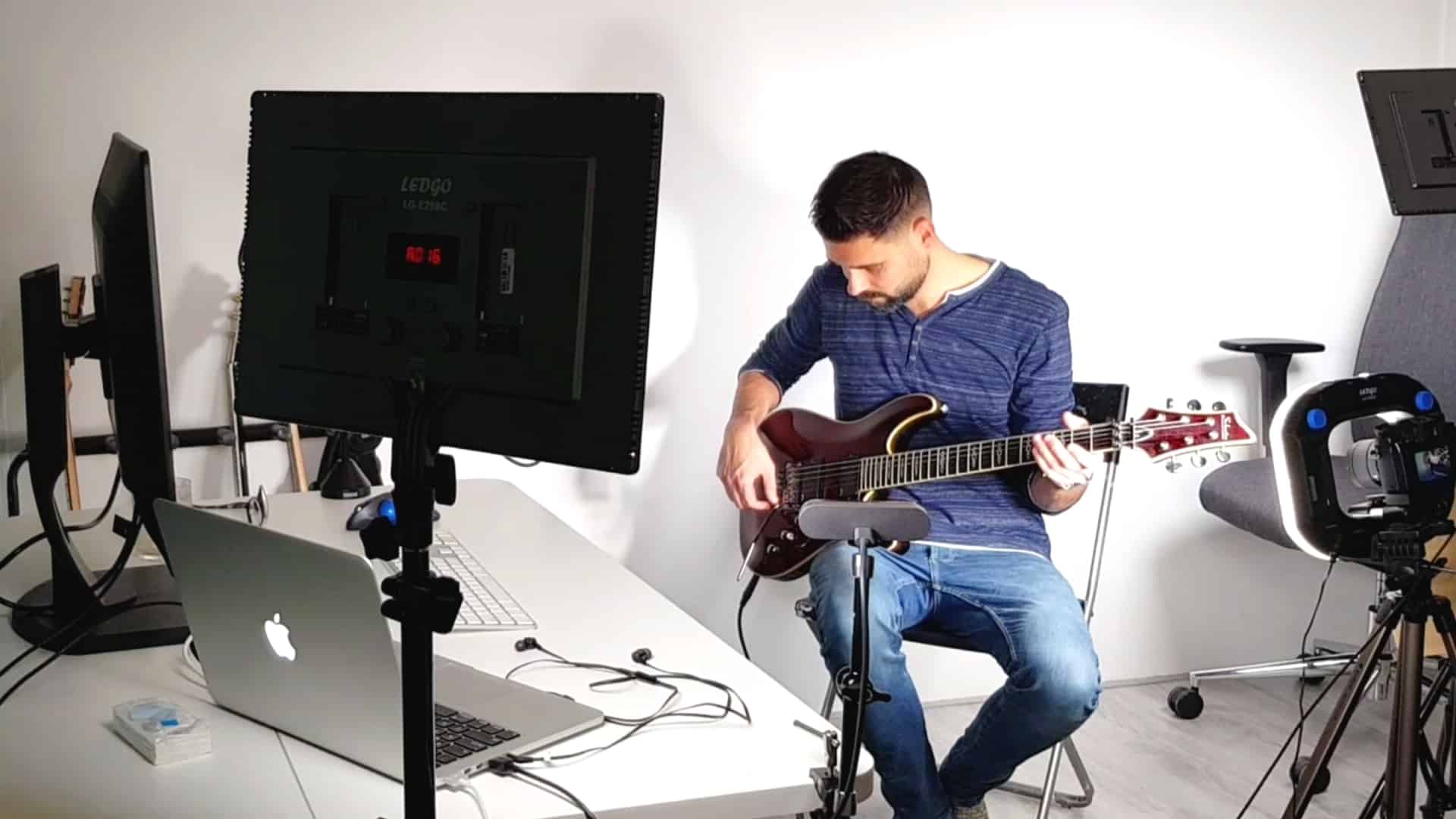Varnish is a liquid that you apply to wood to protect it from dirt, mold, and other contaminants as well as to make it look shiny.
As a guitar builder, you need to know how to apply it properly to get the best results, so in this guide I’ll show you how to do that.

Guitar Varnishing: The Sweet Secret of Shellac
The Sweetest Finish
Guitar varnishing is an essential part of producing a great-sounding instrument. The varnish gives the guitar a glossy finish that looks great and also affects the sound quality. The most popular type of varnish used is shellac, and it’s renowned for its durability and glossy look. But what’s the secret behind this sweet finish?
The Sweetest Secret
It turns out that shellac is actually a processed form of resin secreted by bugs called lac bugs. These bugs live on trees in Thailand and India, and they’re one of the three most useful insects to humankind, alongside the silkworm and honeybee. The resin is totally safe and is even used to coat confectionery and candy.
The Sweetest Application
Applying shellac is an art form in itself. It takes an expert to know how many coats to give and how long to let it dry. But it’s worth it, as shellac is the best natural coating for guitars.
So there you have it – the sweetest secret of guitar varnishing. Shellac is the way to go for a glossy finish and great sound quality. Who knew bugs could be so helpful?
The Benefits of Wiping Varnish for Stringed Instruments
What is Wiping Varnish?
Wiping varnish is a special type of finish that is used on stringed instruments to give them a strong and thin surface. It’s about as durable as lacquer, but much easier to apply – no special equipment or precautions are needed. So, if you’re a beginner at instrument finishing, this is the way to go!
The Advantages of Wiping Varnish
- It’s easy to use and apply
- It provides a strong, thin surface finish
- It’s as durable as lacquer
- You’ll get an excellent finish on the first attempt
- It takes about the same amount of time as lacquer to finish an instrument
Our Experience with Wiping Varnish
We’ve been using wiping varnish for a while now and it’s been a great experience. We’ve found that it’s a great way to get a beautiful finish on our instruments without having to worry about any special equipment or precautions. Plus, it takes about the same amount of time as lacquer to finish an instrument. So, if you’re looking for a quick and easy way to get a great finish on your instrument, wiping varnish is definitely the way to go!
How to Fix Up Your Finishes
Varnish Maintenance
If you’re looking to spruce up your instrument, varnish is the way to go! Unlike paint, which forms one continuous layer, varnish is applied in discrete layers. So if you’re looking to make a major repair to the finish, you’ll need to top it off with an extra layer of varnish. Lucky for you, it’s super simple to do with a wiping varnish.
Spot Repair Techniques
If the repair area is small enough, you can just do a discreet spot repair and it won’t be very noticeable. Here’s what you do:
- Build up coats on the repair area and buff lightly.
- Make sure not to remove finish from the surrounding (undamaged) area.
- Top it off with wax.
The Finishing Touch
Once you’ve done all that, you’re ready to give your instrument the finishing touch. Cover the entire instrument with one or two build coats, a finish coat, and paste wax. Now you’re ready to show off your newly spruced up instrument!
Comparing Varnish and Lacquer Finishes
What is a Varnish Finish?
Varnish is a softer finish material than lacquer, making it more flexible. While it can give your instrument a unique tone, it’s not for everyone. Unlike lacquer, varnish can’t be touched up, meaning any minor imperfections like pinholes, bubbles, or sinks won’t be able to be repaired.
Varnish has a beautiful, rich luster, but it may have small imperfections when examined closely. It’s also not as protective as lacquer, so it’s more vulnerable to scratches, dings, and imprinting. Plus, it can shrink, wrinkle, and dull over time.
Benefits of a Varnish Finish
Although it’s not as durable as lacquer, varnish has its own advantages:
- It allows the instrument to vibrate more freely, making it more responsive and giving it a greater depth of tone.
- It can produce a unique, beautiful luster.
- It’s softer and more flexible than lacquer.
What is a Lacquer Finish?
Lacquer is a hard finish material that’s more durable than varnish. It’s also easier to repair, so any minor imperfections can be touched up. Plus, it’s more protective and can maintain its “new” appearance for longer.
Benefits of a Lacquer Finish
Lacquer has its own advantages:
- It’s more durable and protective than varnish.
- It’s easier to repair, so minor imperfections can be touched up.
- It can maintain its “new” appearance for longer.
The Art of Finishing Wood
Preparing for the Perfect Finish
Finishing wood is a delicate art, and it’s important to get the surface ready before you start. Here’s how to do it:
- Start by sanding the wood with #0000 steel wool to remove any dust from the pores. For woods with a lot of figure, like figured maple, you can sand up to 320 grit to really bring out the grain.
- Vacuum or blow away any remaining dust.
- Wipe oily woods, like rosewood, with lacquer thinner until the rag comes away clean. This will remove any surface oils that could affect the adhesion of the finish.
- If you want to dye or stain the wood, be extra careful to make sure it’s perfectly sanded. Any scratches or imperfections will be very visible once the stain is applied.
- If you’re using a paste grain filler, follow the instructions that come with it.
Applying the Build Coats
Once the surface is ready, it’s time to start applying the build coats. Here’s how to do it:
- Make sure the area you’re working in is as dust-free as possible. Before each coat, blow away any dust with compressed air and then go over all surfaces with a tack rag.
- Prepare an application rag from well-washed, lint-free white cotton, about 8″ square. Fold the rag so all the ripped edges are in the center to keep lint out of the finish.
- Ball up the rag so the wiping varnish isn’t absorbed too much. You should end up with a flat, smooth applicator surface of about 3″ square.
- Apply 10 to 12 coats of finish. The number of coats will depend on the species of wood you’re finishing, but as a rule of thumb, make sure to apply as many coats as it takes to completely fill the end grain, followed by a couple more coats.
- In between coats, buff with #0000 steel wool to eliminate any dust.
- Once you’re done, you can sit back and admire your beautiful finish!
Conclusion
In conclusion, varnish is a great way to give your guitar a unique and satin finish. With just a can of varnish and some practice, you can easily apply it yourself and get the results you want. So, don’t be afraid to give it a go – you’ll be ROCKIN’ in no time! Plus, you’ll be able to show off your new guitar finish to all your friends – they’ll be JEALOUS!
I'm Joost Nusselder, the founder of Neaera and a content marketer, dad, and love trying out new equipment with guitar at the heart of my passion, and together with my team, I've been creating in-depth blog articles since 2020 to help loyal readers with recording and guitar tips.


